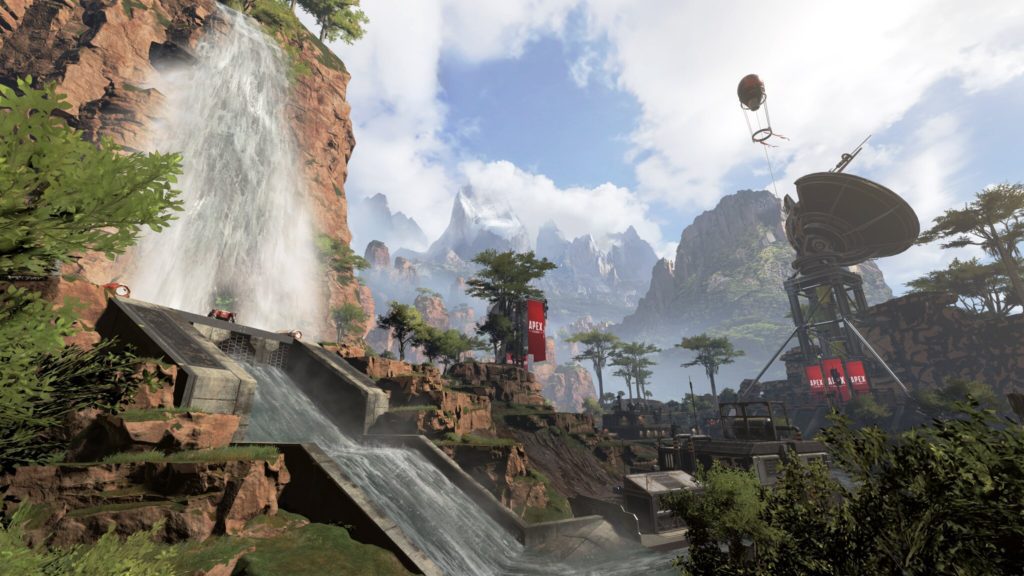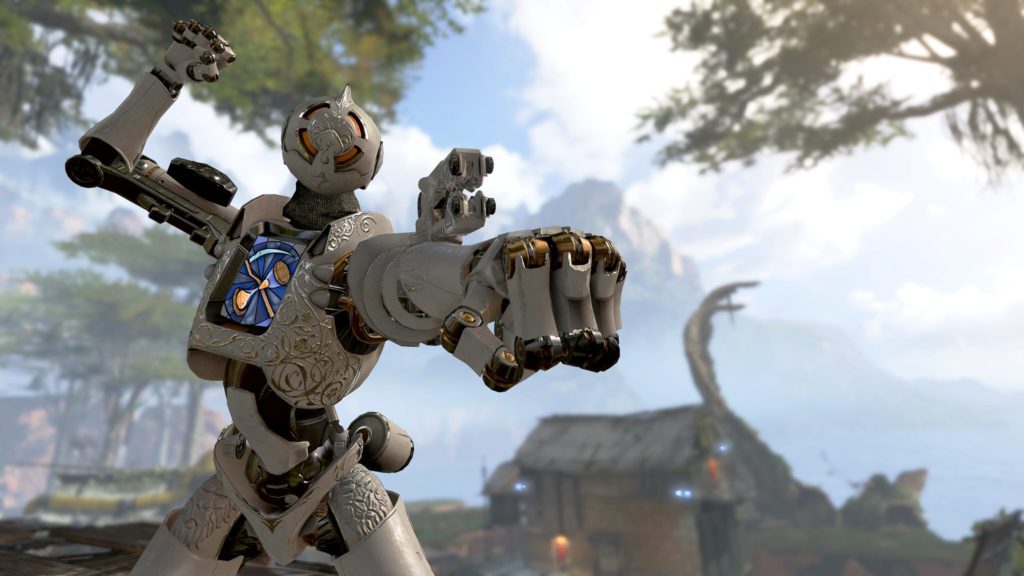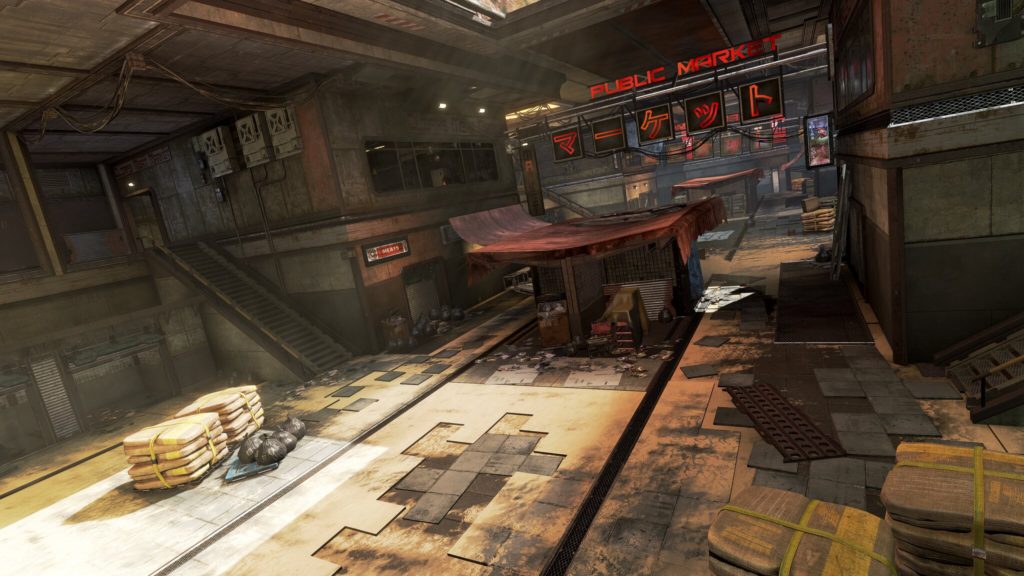Situated at the forefront of the Titanfall 2 campaign, the gauntlet trial served as a primer for the game’s renowned versatility of movement and unbounded verticality. A test of speed, accuracy and balance condensed into a diminutive obstacle course, the gauntlet was there to be mastered—an island of technical perfectionism that sat alone in an ocean of chaotic spontaneity. Here was a narrow corridor where bone white brickwork was the running track for a sub-minute sprint, with the painstaking struggle for seconds of progress playing only a minor part in a marathon of missteps. For in that half-a-minute period existed a record-setting run, a run that was nestled in between acts of premature failure and understandable defeatism, but a run that would eventually see you attain a podium finish, pop the trophy, and continue through the early-game experience all the more confident in your abilities. You would likely never be that good again, of course. The gauntlet may have shown you what you were capable of, but its lessons weren’t ones that were meant to be translated free of interpretation. On a battlefield stalked by giant robots and illuminated by burning laser trails, the most apt message imparted by the gauntlet was that success is best measured on a second by second basis.
On February 4th 2019, Apex Legends, a new shooter based within the Titanfall universe, arrived on all major platforms. Adhering to the battle royale blueprint that had been popularised by PlayerUnknown’s Battlegrounds and iterated upon by Epic Games’ Fortnite, Respawn implemented their take on the genre with few alterations to the existing formula. When it came to adapting Titanfall for this new single-elimination format, Apex Legends felt just as comfortably familiar as many of the titles that had preceded it. Matches would begin with an aerial dive onto the map, and a desperate scramble for a weapon would kickstart a 20-minute fight for survival. So as long as a member of your team was still alive, you still had a chance to win, but unlike other team-based shooters outside of the genre, you weren’t likely to be back on your feet seconds after being taken out. And ensuring that the intensity of the match never dulled, the deadly laser-grid perimeter would gradually push players towards its centre, with the ranged encounters of the initial minutes soon replaced by point-blank jousts to decide a final victor.
Just as important as what Apex did differently was how well it executed the basics. Before the game’s banner system, dynamic weapon customisation and ability-based character design had solidified themselves as prominent fixtures of Respawn’s new title, the responsiveness of shooting and fluidity of movement stood out all their own. And in both cases, the influence of Titanfall turned out to be a significant boon. When it came to the former, the snappy targeting and satisfying feedback of gunplay that had been typical of Respawn’s future-shooter made its welcome return, albeit with a sharply increased time-to-kill. But when it came to the latter, the boundless exploitation of motion already drilled into every Titan pilot and Frontier fighter would serve as invaluable experience for the fights to come, with the intrinsic pace and verticality of Titanfall making a seamless transition to this new arena and its much grander scale. Without a doubt, one of the most interesting aspects of battle royale games is the level playing field that players are met with at the start of each match. If you’re lucky enough to find a gun before your nearest opponent, then you’re going to have a distinct advantage should you decide to compete for an early kill or two. There’s definitely an element of luck to these opening salvos, but whether you’ve already armed yourself or not, victory is never a foregone conclusion for the aggressor of each conflict. In Apex Legends, every player, gun or no gun, can run, sprint, jump, slide and climb. At the very core of the game is movement, and how you choose to harness the means that are available to you can ultimately be the difference between being the first of the herd to drop, or being one of the last left alive. At its simplest, the freedom to elevate your speed by sliding down a hilltop, or create a shortcut by vaulting a wall can alleviate much of the downtime that occurs between skirmishes. Although anxiously checking your magazines may still take precedence during breaks in play, its dependance on player agency means that traversal becomes much more than just an exercise in passivity. There are a multitude of ways in which you can surmount the environment ahead of you, and it’s often the most imaginative approach that proves to be the most profitable route to victory.
* * *
The ingenuity of movement and the deeper mechanics of its application is best evidenced within the throes of combat, where snap decisions and miscalculations translate into hectic battles for territory. Though it may be difficult to incorporate attacking, evading and repositioning into a single motion, you’re never left without an opportunity to gain control of a battle and influence its outcome. However uncultured your jostling and clambering may initially seem, a mastery of movement can only be attained through perseverance. Experimentation is key, and with so many different characters to utilise in battle, each bringing new equipment and abilities into the fray, order and chaos are often meted out in equal measure. The goal here is to be able to do it all without thinking, allowing muscle memory to take over as you bank into a slide at the perfect angle, or execute a controlled leap out of harms way. As you begin to develop an understanding of your limitations within the environment, so will you become more adept at pulling off complex feats of skilful deception and marked tactical nous. Perhaps the biggest achievement of Apex Legends is condensing its entire suite of movement capabilities into single button presses. The barrier of entry for Apex is low, and much of that is due to the way in which it scales down the complexity of its systems so that they remain widely accessible. Marking the position of an enemy, for example, is as simple as aiming in that particular direction and then tapping the shoulder button once. And for all of the versatility of movement that the game offers, none of it is beyond the reach of the average player. Unlike the game’s roster of characters, the movement mechanic isn’t an elective that you can choose to ignore. Forced into action unexpectedly, you will instinctively slide into cover to escape the onslaught, and then sprint for the position from which to commence your retaliation. Persistent, dynamic motion is ingrained into the very fabric of the game, and an education in its many facets is an education in the enduring legacy of Titanfall.
As of its one year anniversary, Respawn has added a second map to the game, with the older of the two, Kings Canyon, largely giving way to the newer, more visually distinctive World’s Edge. Despite differences in aesthetic, the two arenas both share a similar shape, with the dozen or so battlefields that comprise each larger map designed so as to be assaulted from multiple angles. Between their towering peaks and cavernous valleys, the tectonic displacement of both maps ensures that no single position is infallible, with even the most enclosed areas susceptible to a sudden bullrush by a team working completely in tandem. Becoming more knowledgable of your surroundings doesn’t just help in your moment-to-moment decision making, but it also lessens the authority that the ring has in dictating your next move. When it comes to punishing players that spend too long behind the pace, the ring doesn’t discriminate, serving up equal damage to everyone caught within its fiery maw. And knowing that you’re capable of outrunning it leaves you with much more time to plan for the endgame. Understanding the lay of the land, as well as the ring’s trajectory, can allow for you and your team break through defensive lines completely unseen, or even avoid whole conflicts altogether. You’re in the business of prolonging your survival foremost, and though mistakes will likely be attributed to many of your defeats, you’re rarely dependant on any factors other than an ability to move, survive and fight. Both King’s Canyon and World’s Edge espouse the same level of consistency in design, with the fluidity of motion and rhythm of movement baked into every clifftop pathway and winding river. No matter where the fight takes place, your knowledge of the environment and the way that you utilise your surroundings will always count for something. And to that end, there are plenty of secrets to be found that aren’t confined to the lines and contours of your personal map.
* * *
It only ever takes a single ping towards a zip-line to relay your intent to move, with the non-verbal team-play of Apex a ray of clarity that helps to guide your squad through the mayhem. The relationship between the player and the environment begins with communication, and over time, evolves into a tangible, tactical proficiency. By continually sharpening your senses and growing into the pace of the game match by match, Apex gradually begins to impart more of itself onto the player, with your attentiveness often rewarded. With such tremendous sound design narrating the vivid tumult of war, you’re able to hear things long before they become a threat, such as the sound of distant battles being carried on the wind, or the lumbering gait of unseen footsteps heading in your direction. In addition, open doorways, disturbed ammunition packages and recently vacated equipment hold similar reminders that the world you inhabit is persistent, occupied as it is by many other players all walking a similar path. There’s assurance to be found in your understanding of the game, but reacting to the ever-changing environment is a large part of what keeps it enjoyable even after hundreds of hours. With such a dynamic roster of characters keeping the balance of play in a constant flux, adapting to the situation becomes a key part of the experience. Next to the unpredictability of character combinations, the symbiosis of their abilities and the ways in which they each manipulate movement, no matter who you come up against, no two battles are likely to pan out exactly the same.
Boiling down the intricacies of their design, the characters of the Apex arena all feed into the game’s inherent cycle of movement, if not through offensive capability, then by utilising the means of area denial or escape. Despite each character being confined to only two active abilities and one passive, the collective viability of the whole roster never confines them to only a single, specific role. The turbo-charged Octane, for example, can deploy a jump pad in a pinch, which serves as both a useful means of escape, as well as a potent tool for reaching an otherwise inaccessible area. The sinister Caustic meanwhile can blockade an area with motion-triggered gas traps, which are as useful for defending an area as they are for pinpointing the location of pursuing teams. The depth of movement in Apex doesn’t just define how you advance through the map, but how you can dictate the moves of your opponent through use of the equipment and skills at your disposal. Characters like Wattson, with her deployable laser fences, and Gibraltar, with his aerial ordnance, both offer two different ways of achieving the same outcome—as the fences deny entry to an area and even force the enemy to reconsider their approach, the much more bombastic ordnance canister can send them running for cover in a pinch, By ferrying an opponent in a particular direction, you will be able to predict their next move, and just how you choose to take advantage of the situation is where the originality of Apex rises to the fore.
The intangible appeal of Apex Legends is evident in the way that such an unmistakably important part of the game is reduced to a process of reactionary, thoughtless input. Before long, as dozens of matches bleed into hundreds more, the basic joy of movement is superseded by the delight of using it successfully, often in order to secure a long-awaited return to the champion’s podium. As the once complex and challenging nature of movement is gradually eroded away by your own flourishing skill, your input in executing perfectly timed slides, dives and dodges lessens significantly, with the passive tutoring that the game provides slowly relinquishing you from its grip. Apex Legends has no building mechanic to wrestle with, nor any other unavoidable metagame that warrants its own attention. But what it does have is an impressively intuitive method for ensuring that even the most unexperienced competitors can have their moment in the sun. There’s no gauntlet to fear here, no ticking clock to condemn the slightest hesitation. Along the way back to the top of the pile, there’ll be plenty of missteps as you pivot and parry for every extra second. In the game of survival, the perfectly executed offensive and the unwittingly choreographed escape plan both have an equal place amongst the chaos.


